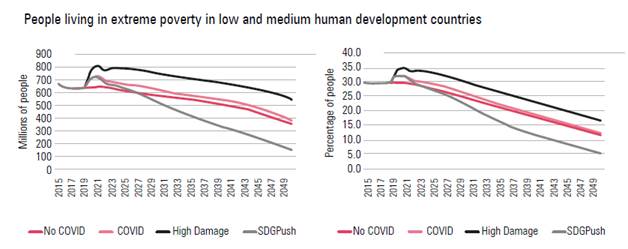INTRODUCTION
Achieving the Sustainable Development Goals (SDGs) has been facing challenges even before the COVID-19 pandemic. The UN report on the SDGs progress highlights that despite progress in a number of domains, on some of the goals, progress has been slow or even reversed. Extreme poverty and child mortality rates continued to decline and incidence of certain chronic diseases has been reduced considerably and certain targets of gender equality have seen progress and many countries are taking actions to protect the environment. However, despite recording its lowest point since tracking, poverty rate was projected to be 6% in 2030. Hunger has been on the rise for the third consecutive year; biodiversity has been lost at an alarming rate and greenhouse gas emissions have continued to increase. The pre pandemic period also witnessed a lag in the required level of sustainable development financing and other means of implementation as well as an absence of strong and effective institutions to respond adequately to these massive and interrelated cross- border challenges (Gonzalez-Perez, Mahmoud, Hult & Velez-Ocampo, 2021; Mahmoud, Piedrahita- Carvajal, Velez-Ocampo & Gonzalez-Perez, 2021).
The path to the SDGs implementation has been witnessing heterogeneities within and across countries, thus slowing down any progress towards “leaving no one behind”. There are substantial divergences across regions and among countries, with the most vulnerable and low-income developing countries lagging progress on SDGs and bearing the burden of the ongoing obstacles to the SDGs implementation as shown in (Figure 1). About 84.3% of multidimensionally poor people live in Sub-Saharan Africa and South Asia, the Arab Region witnessed the only increase in extreme poverty as a result of conflicts that plague the region and Africa remains largely off track on the 2030 Agenda (ESCWA, 2020; OPHI & UNDP, 2020; SDGCA, 2020).
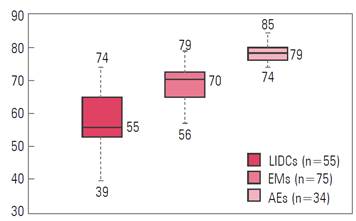
Source: Benedek et al., A Post-Pandemic Assessment of the Sustainable Development Goals, 2021 Numbers are based on 2020 SDG Index; and Dashboard Reports. Note: The SDG Index aggregates data on individual SDGs into a composite index. The index is based on pre-COVID-19 data. Plots exclude extreme values for emerging markets (EMs) and advanced economies (AEs). LIDC = low-income developing country.
Figure 1: SDG Composite Index, 2020 (Range: 0-100)
Even within the same country, rural and urban differentials are evident in areas such as poverty reduction, education and health care (UN, 2019). To demonstrate, of the over 400 million who are projected to remain poor in 2030 in Africa, two thirds are projected to be in rural areas (SDGCA, 2020). All of these facts combined underscore that as of 2019 the world was not moving fast enough towards achieving the 2030 Agenda. In 2020, the COVID-19 pandemic threatens to reverse a lot of the progress that has been achieved towards the SDGs. The Human Development Index (HDI) was estimated to suffer a “steep and unprecedented decline” in 2020 for the first time since the measure has been computed 30 years ago as reflected in Figure 2.
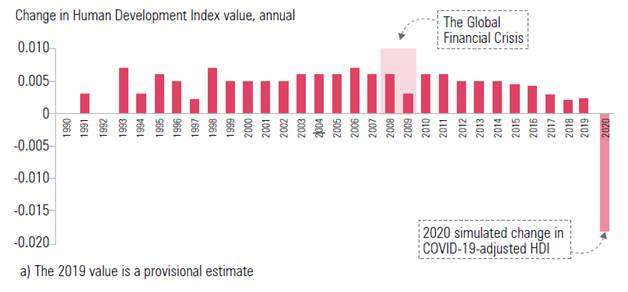
Source: UNDP, COVID-19 and Human Development, p.6, 2020
Figure 2: COVID-19 impact on Human Development
Preliminary estimates by the United Nations and the World Bank reveal that around 71 million to 115 million people are expected to be pushed back into extreme poverty, with revised new estimates showing the COVID-19-induced new poor in 2020 are expected to rise to between 119 and 124 million as shown in Figure 3. And while the 2021 estimates are still preliminary, the estimated COVID-19-induced poor is expected to increase between 143 and 163 million, highlighting that for millions of people this crisis will not be short-lived (World Bank, 2020).
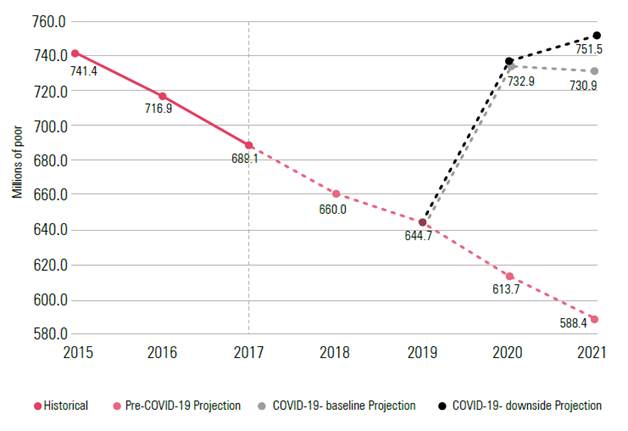
Source: World Bank, January 2021 https://blogs.worldbank.org/opendata/updated-estimates-impact-COVID-19-global-poverty-looking-back- 2020-and-outlook-2021
Figure 3 Number of people living in extreme poverty, 2015-2021
This in turn marks the first rise in global poverty since 1998. As more families fall into extreme poverty, children in poor and disadvantaged communities are at much greater risk of child labor, child marriage and child traficking, threatening to reverse global gains achieved in reducing child labor for the first time in 20 years (UN, 2020a). The effect of the COVID-19 pandemic is expected to be more acute to the most vulnerable communities. For instance, the more than one billion slum dwellers worldwide are at the highest risk of exposure to COVID-19 as a result of lack of adequate housing, running water and waste management systems along with limited access to formal healthcare facilities (UN, 2020a). The effect of the crisis is expected to be aggravated because it is superimposed on and interacts with inequalities and global tensions: between people and technology, between people and nature, and between the haves and the have- nots (UNDP, 2020). Heterogeneities in the impact of COVID-19 are also expected across countries. Eight out of 10 people slipping below the extreme poverty line will be in middle-income countries (World Bank, 2020). The COVID-19 crisis has thus exacerbated inequality with the IMF estimates that the average Gini coeficient could increase by 2.6 percentage points for emerging market and developing economies, erasing equity gains since the 2008 global financial crisis Figure 4. The COVID-19 pandemic has thus highlighted the need to tackle the root causes of vulnerability; an aspect stressed upon in the 2030 Agenda.
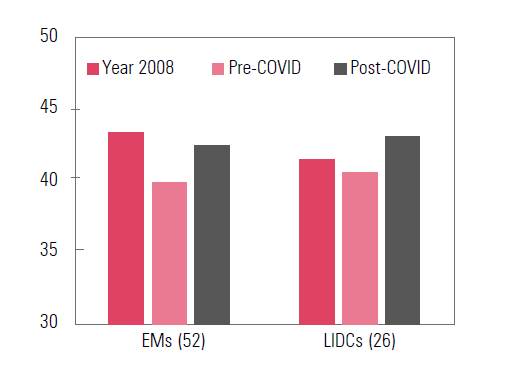
Source: Benedek et al., A Post-Pandemic Assessment of the Sustainable Development Goals, 2021 Numbers are based on IMF, World Economic Outlook, 2020
Figure 4: Change in Inequality due to COVID-19 (Gini coefficient, percent, estimate)
Given this background, this literature review aims at looking at the literature that covers the role of the different actors towards achieving the SDGs, namely national governments; local and regional governments and local communities3, and the business sector as well as the interactions required among these actors to facilitate the implementation of the SDGs. This analysis builds on the initial agreements among governments in the run-up to the 2012 UN Conference on Sustainable Development, where governments agreed to “establish an inclusive and transparent intergovernmental process on sustainable development goals that is open to all stakeholders” (UN, 2012). The last part of the review goes on to highlight how the COVID-19 pandemic provides a new scope for new trends in sustainability and integrating the “building back better” notion in response to the pandemic.
1. THE ROLE OF GOVERNMENT
Implementation of the SDGs is a matter of governance and coordination among numerous actors, but in an original context where national governments were believed to be a key to success (Dalby et al., 2019). However, because national governments have different capabilities and priorities and face different challenges, it is impossible to generalize and speak of national governments as a uniform category (Monkelbaan, 2019, p.55). Still, studies analyzing countries’ Voluntary National Reviews (VNRs) and national development plans find that establishing the structure of a governance system for the SDGs was one of the primary actions taken at the national level (Allen, 2018; Morita et al., 2020). This first step is believed to be crucial for the collective success of the SDGs, especially if the established national governance mechanisms are flexible, translate the global ambitions into national contexts, formalize the state’s commitments and allow for stakeholder engagement (Biermann et al., 2017; Morita et al., 2020). However, a closer look at the countries’ VNRs submitted so far reveal that developing a governance system for coordination and consultation on the SDGs is not enough per se. For instance, based on a review of 2016 VNRs, Allen et al. (2018) find that limited progress has been made at the national level in planning stages focusing on target setting, assessing interlinkages between targets and policy evaluation. The integrated nature of the SDGs necessitates carrying out these policy exercises to ensure that feedback loops among the targets are understood and managed (Allen et al., 2018). Even studies that analyze more recent VNRs find that only 43 countries report assessing policy coherence in their national governance systems and the lead is driven by European countries, which follow the Policy Coherence for Sustainable Development (PCSD) mechanism promoted by the OECD (Okitasari et al., 2019). This divergence also exists in the usage of indicator-based assessment and benchmarking. OECD countries were found to be more advanced in monitoring and reviewing arrangements which reflect their greater statistical data and capabilities; factors that map to potentially more effective SDGs tracking in implementation (Allen et al., 2018). Additionally, mainstreaming of the 2030 Agenda into National Frameworks up to 2018 lacks reference to key global agreements on climate change, disaster risk reduction, and the New Urban Agenda (Okitasari et al., 2019). Similarly, despite some positive trends in public participation and governments’ involvement of broader stakeholders in the consultation processes for SDGs mainstreaming at the national level, only few countries appear to be making concerted efforts to meaningfully enhance multi-stakeholder partnerships (Okitasari et al., 2019; UN DESA, 2020). Lastly, whereas most countries have made a commitment to identify public sources of funding, fewer have calculated the cost of implementing steps to achieve the SDGs, identified non-public finding opportunities, or developed a framework to boost private-sector financing for the SDGs (Biermann et al., 2017; Okitasari et al., 2019).
The studies mentioned earlier that look at the governance systems required or established for the SDGs especially on the national level appear to focus on the role of national government as an authority entrusted with articulating the issues faced by the society and then act to create an enabling environment for SDG implementation rather than being a monopolist and pure problem solver (Monkelbaan, 2019, p.55). Under this approach, national governments are responsible for developing robust vertical and horizontal governance mechanisms to address cross-cutting and complex sustainability issues. Such governance mechanisms should support a whole- of-government approach as well as cross-sector and multi-stakeholder partnerships that go beyond consultations (Okitasari et al., 2019). However, evidence suggests that the principal issue for national governments is how to align policies in practice given the breadth and complexity of the SDGs, the necessity for governments to work horizontally and the need to include an unprecedented range of public and private actors in both policy formulation and implementation, all of which are factors that hinder translating institutional arrangements into effective implementation strategies (de Mello, 2016; UN DESA, 2020). This is further complicated by the fact that immediate economic and social pressures and vested interests that often crowd out policy initiatives, especially when the benefits from the latter span elector terms (de Mello, 2016; Soto, 2015). Despite progress in establishing governance systems for SDGs and efforts to mainstream SDGs in national plans, evidence increasingly suggests that many national governments appear to be ineffective in the face of global challenges such as climate change, the refugee crisis and the persistent inequality even in many of the G20 countries, just to name a few (Dalby et al., 2019). The rise of the right-wing populist movements further complicates national governments’ commitment to the 2030 Agenda because of administrations that view the context for policy as one for competing national states, thus oppose global initiatives (Dalby et al., 2019). This is aggravated by a discrepancy between expressed political support for SDGs and the integration of SDGs in strategic public policy processes, including national budgets (Dalby et al., 2019; UN, 2020b).
Other studies focus on the commitment of national governments to the SDGs through the channel of domestically focused mechanisms of public finance (Suttor- Sorel and Hercelin, 2020; Dasgupta, 2021, p.468-472). Public finance can affect the SDGs by providing incentives for more sustainable production or consumption pattens or generating revenues that can be harnessed to finance the SDGs. For example, if we focus on the environmental SDGs, we find that across countries the majority of public finance for enhancing domestic natural assets is allocated via domestic budgets and tax policies, with around 229 biodiversity-relevant taxes, of which 206 are in effect (Dasgupta, 2021, p.469). Other instruments used by public finance in biodiversity preservation are biodiversity-relevant subsidies along with other mechanisms such as payments for ecosystems (PES), biodiversity offsets, raising finance through sovereign and green bonds where funds invested in these bonds are devoted for financing projects that are deemed climate responsible or environmentally friendly (Dasgupta, 2021, pp.470-471). Additionally, governments can increase revenues from other non-tax sources by stronger management of government assets. According to 2018 estimates, potential average revenue gain from better can reach 3% of GDP a year, which provides a space to finance shortfalls in SDG financing (IMF, 2018). Besides, national governments are in charge of providing the adequate mix of regulations, macroeconomic stability, and improved governance and business climate to attract business investments in the SDGs (Zhan et al., 2021). In many contexts, governments step up to overcome SDGs-private investment barriers and mobilize sources of private funding via different mechanisms and initiatives; the famous of which is blended finance. In blended finance, governments provide catalytic capital to increase private sector investment in sustainable development. This happens usually through both grants and guarantees to cover or decrease the risks related to loans and equities. By their structure blended finance mechanisms can communicate to investors the potential financial returns of a project, de-risk it and develop proof-of-concept for innovative projects (Suttor-Sorel and Hercelin, 2020; Dasgupta, 2021, p.478-479).
Despite some progress on public finance mobilization for SDGs, government efforts are still limited and small in size compared to capabilities and the progress required. For instance, the total amount of resource collected from biodiversity- relevant taxes is still small. LIDCs are plagued with ineficient public investment management. Estimates reveal that the average LIDC loses about 53% of the returns on its investments to ineficient public investment management (IMF, 2015; Shwartz et al., 2020). Moreover, in some areas public financial flows that are detrimental to SDG progress dwarf those flows devoted to enhancing the 2030 goals. For example, in many countries most of public finances directed towards subsidies goes to activities that are detrimental to ecosystems and biodiversity (Dasgupta, 2021, p.468-470). Recent estimates have shown that the true environmental cost of some subsidies is much larger than their monetary cost. When accounting for the negative externalities arising from fossil fuel subsidies, the resulting aggregate cost of such subsidies is estimated to be around USD 5.2 trillion annually (6.5% of GDP in 2017) (Coady et al., 2019). This provides an example of the failure of governments that tend to exacerbate market price distortions, coupled with their failure to fully internalize externalities through fiscal measure and standards and regulations setting (Dasgupta, 2021, p. 467).
2. ROLE OF LOCAL AND REGIONAL GOVERNMENTS AND COMMUNITIES
The degree of success of national governments in providing the required policy frameworks for stakeholders’ engagement can be assessed by looking at the role played, and challenges faced by the other actors. For instance, cities and local communities are becoming increasingly important in making progress towards the SDGs. Scholars highlight that the 21st century will not be dominated by nation states but by cities which are becoming the islands of governance as well as catalysts of almost every aspect of the global system (Fenton & Gustafsson, 2017; Khanna, 2010). The SDGs themselves emphasize the importance of cities and human settlements for implementing these universal objectives, indicating the need for local action that serves global interests and aligns with local profiles (Fenton & Gustafsson, 2017; Valencia et al., 2019). It is estimated that at least 105 of the 169 SDG targets cannot be reached without proper engagement of sub-national and regional governments (OECD, 2020). However, despite the importance of cities and human settlements to the SDGs as well as the existence of Goal 11, some scholars suggest the 2030 Agenda is more explicit concerning proposed approaches at the international and national levels than for the local level (Fenton and Gustafsson, 2017).
To reach general conclusions about local governances for the SDGs, scholars either review various studies to identify the potential challenges and opportunities focusing on municipalities (Fenton and Gustafsson, 2017) or draw insights from studying certain cities from different countries (Gustafsson and Ivner, 2018; Krellenberg et al., 2019; Valencia et al., 2019). For example, Valencia et al. (2019) use a five-aspect approach in looking into localizing SDGs. The five aspects are: delimitation of urban boundary, integrated governance, actors and the importance of local champions, synergies and tradeoffs and the use of indicators. The study focuses on these five aspects in studying seven cities in four continents, ranging from large metropolitan areas to intermediate and small-sized cities across the Global North and South. The study concludes that political will, coherent governance, and strong formal partnerships between public sector, private sector and civil society actors are key ingredients in achieving the SDGs. Analyzing four cities across Europe, Russia and the United States, Krellenberg et al. (2019) focus on the aspects of planning, implementing and monitoring sustainability strategies that cities struggle with in SDGs context. Similar approach is followed in Gustafsson and Ivner (2018) who examine the Östergötland region in Sweden to identify the roles of municipalities in the SDGs implementation process and provide recommendations to organizations adopting the SDGs.
Evidence from various initiatives highlight the importance of cities in filling some of governance gaps that have been caused by the failure of national governments. Examples include unilateral reduction of GHG at the municipal level and Emissions Trading Schemes (ETS) at the subnational level (e.g. California ETS), British Columbia’s carbon tax, Melbourne’s goal to become carbon neutral by 2025 and Tokyo’s ETS. Similarly, the “We Are Still In” Alliance includes cities and states along with universities and corporations which voluntarily declared their continuation to support climate action to meet the Paris Agreement after the United States’ withdrawal (Monkelbaan, 2019, p.50). More than 10,000 local and regional governments (LRGs) from 135 countries have committed themselves to take measurable actions to reduce GHG emissions, highlighting the leading role played by LRGs in dealing with climate change (UCLG, 2020). Hundreds of cities have also embedded the SDGs in their local strategies and medium-term planning objectives and sought to strengthen their partnerships with local stakeholders (UCLG, 2020). Cities have also been taking the lead in SDG 17 by building close networks with local, governmental and international bodies, the private sector and the civil society. Diverse cross- border networks of global cities are also seen as the future of global governance.
Global initiatives like Cities for Climate Protection (CCP) program, the Covenant of Mayors, the C40 along with other initiatives focused on sustainable development seek to establish and improve linkages between local and international governance levels, sometimes bypassing the national level (Monkelbaan, 2019, p.54; OECD, 2020). It is also claimed that national and transnational municipal networks play a dual role in horizontal and vertical governance, thus promoting governance by diffusion between municipalities and thereby contributing to intra-municipal transformations. These networks also represent the sum of intra-municipal and inter-municipal actions vertically into national and international debates, thus transcending municipal boundaries (Benz et al., 2015; Fenton & Gustafsson, 2017). Another example for the willingness of local and regional governments to engage in the global agenda is the emergence of Voluntary Local Reviews which can be used to strengthen the localization of the SDGs by helping spread awareness about the SDGs and monitor their implementation at the grassroots level, where accelerated actions can often have the most positive aspects (OECD, 2020; ULCG, 2020, UN DESA, 2020). This is further strengthened by the efforts of some cities to localize the SDGs by measuring progress at the subnational level, with Bonn and Kutakyushu providing examples where indicators have been contextualized.
Despite the role played by local and regional governments towards achieving the SDGs, LRGs still face a lot of challenges in carrying out their tasks as well as being neglected in national consultations. For instance, while the local and regional governments’ involvement in the VNR processes has increased to 55% in 2020, up from 42% in 2016-2019, their involvement in most national coordination mechanisms is still very low (UCLG, 2020). According to UCLG, regular consultation has only been acknowledged in 31% of the countries that have reported since 2016. In many different regions, there is a critical mismatch between the increased responsibilities and the revenues allocated to LRGs (Krellenberg et al., 2019; UCLG, 2020; UN DESA, 2020). Although cities account for 80% of global GDP, many fast-growing cities fail to capture such wealth leading them to suffer from having insuficient budgets, infrastructure deficits, informal economies-which reduce the revenue base and substandard services. Cities’ local autonomy is further restricted by constrained institutional frameworks, overlapping power allocations, strong oversights from higher tiers of government and intergovernmental transfers; all of which are factors that are acutely pronounced especially in developing economies where borrowing is still constrained for the majority of LRGs (UCLG 2020). This lack of funds highlights that most states miss the type of integrated national financing framework required to support SDG implementation strategies that are called for in the Addis Ababa Action Agenda. Variation across municipalities’ capacities is another challenge LRGs face. Small municipalities naturally have fewer human resources capacity to monitor the SDGs and often need support from national governments, which tend to be reluctant (OECD, 2020). These challenges have become increasingly critical with LGRs on the forefront of dealing with the immediate effects of the pandemic.
Localizing the SDGs also highlights the crucial role that the civil society and community-based organization play as localization calls for an inclusive approach that utilizes local knowledge to tailor the global-development agenda to specific local circumstances (Corella et al., 2020; DDP, 2016; IISD, 2017). The key areas in which Civil Society Organizations (CSOs) work to implement the SDGs locally can be categorized as follows: representation, realization, serving as agents of accountability, monitoring progress through data collection and reporting, and acting as transmission mechanisms (Corella et al., 2020; DDP, 2016; IISD, 2017; Long, 2018). Firstly, CSOs contribute to the implementation as being representatives of disadvantaged, vulnerable and marginalized groups as well as various causes such as the interests of future generations, environmental conservation, among others. CSOs thus contribute to the 2030 Agenda underlying principle of Leaving No One Behind and ensure the participatory quality of SDGs implementation that guarantees that national priorities reflect people’s lived realities, with examples including the Disability Alliance on SDGs in Bangladesh and the Liberia CSOs against female genital mutilation (DDP, 2016; Long 2018; UN DESA, 2020). CSOs can also develop partnerships with the local and national governments to ensure that local resources are mobilized for those who are most vulnerable and that their needs are reflected in local development plans and national public policies (DDP, 2016). The second area CSOs contribute to is as one of several agents who directly contribute to achieving the outcomes envisioned in the 2030 Agenda. This contribution to realization can be direct through CSOs capacity in service delivery and expertise in designing and employing means of implementation as well as indirectly by removing obstacles to implementation (DDP, 2016; Long, 2018). In some countries, civil society is integrated more thoroughly into larger, open structures of national implementation like in Finland which has an open portal through which CSOs can register their commitments to contributions to “the Finland we all want by 2050” (Long, 2018).
The role of CSOs as service delivery agents become particularly relevant in areas affected by conflict and characterized by elevated levels of poverty and lack of access to basic services where CSOs are often more flexible and can identify creative and innovative alternatives to development (DDP, 2016). This is the case in Somalia where CSOs have filled the vacuum of service provision left by the collapse of the Somali State and thus play a role in providing vital services as well as preparing policy proposals to influence the national and local policy making processes (SIDRA, 2020).
Thirdly, CSOs play the role of monitoring and reviewing to hold states and other actors to their commitments and highlight poor practice. Moreover, some CSOs produce independent or alternative or shadow reports at national level, reacting to governments and providing different perspectives when needed (Corella et al., 2020; DDP, 2016; Long, 2018). The role of CSOs as agents of accountability aligns with the increase in citizens’ worldwide demand for transparency, participation and accountability in government operations (Bhargava et al., 2019). Fourthly, CSOs play a role in the needed Post-2015 Agenda data revolution. The 2030 Agenda comes with the imperative of innovating data collection systems that are low-cost and ensure that data are accurate, timely and immediately available to the policymakers and the public as well as disaggregated to reflect the status on the local levels. In their capacity of being connected to the people, CSOs can both participate in collecting the data as well as encourage people to use any new platforms established to keep up with the data requirements (Corella et al., 2020; DDP, 2016). “Localizing the SDGs in Colombian cities” led by the Cómo Vamos Cities Network (CVCN) and its main partner Fundación Corona is an example of an initiative that supports city level Sustainable Development Goal strategy and achievement efforts by developing data tools that can be adapted to cities’ varying contexts, including a common list of city-level SDG data indicators and targets and an open data platform (TRENDS, 2019). Lastly, CSOs function as transmission mechanisms for ideas and information between the empowered space of decision making and the wider public sphere. By bringing public interests into decision-making processes and by circulating information outwards, CSOs enhance public awareness and engagement with the SDGs which loops back to higher public pressure on governments to commit to the SDGs (Corella et al. 2020; Long, 2018).
Despite the proliferation of the role of civil society towards achieving the 2030 Agenda, the literature also highlights the challenges CSOs face. First off, the CSOs usually operate in spaces that are defined by the state. The state can enable or constrain the space in which CSOs organize and operate and thus determine the ways in which CSOs can engage with the sphere of decision-making (Corella et al., 2020; Long, 2018). Additionally, although all the 193 UN states committed to involving Civil Society in the 2030 Agenda, analysis of the VNRs submitted between 2016-18 as well as accounts given by CSOs contribution to the HLPFs suggest that few governments have encouraged informed collaboration and few opportunities have emerged for CSOs to participate in oficial national conversations thus highlighting that CSOs have not been appropriately involved thus far (Bhargava et al., 2019; Corella et al., 2020). Even when the VNRs highlight the contributions of CSOs, they do so in a manner that tend to spotlight success stories rather than taking a critical analysis approach (Corella et al. 2020). In addition, evidence suggests that CSOs can be directly contributing to the SDGs, for example through service delivery, but fail to map their outcomes to the goals or targets, thus raising the issue of the importance of CSOs reporting (Long, 2018). In many cases, such as Costa Rica, maintaining Civil Society participation momentum in government-led initiatives has proved to be hard because it is challenging to unite members under a shared agenda and the proliferation of forums, spaces and platforms sometimes surpasses the civil society capacities (Corella et al., 2020; UN DESA, 2020). Lastly, financial stability and sustainability continue to be critical issues for CSOs particularly in several middle-income countries where donors tend to pull out. This leaves the CSOs financial sustainability vulnerable to the financial swings and donor interest (Corella et al., 2020).
3. ROLE OF THE BUSINESS SECTOR
The business sector is a key actor because it is where most of the innovation occurs along with its capacity to create jobs and conditions for people to fulfill their potential if provided with the right incentives as highlighted by Pietro Bertazzi4 (Martinuzzi & Schönherr, 2019, p.10). Additionally, businesses that go beyond corporate social responsibility and invest seriously in sustainable development have an essential role in supporting the 2030 Agenda when it comes to financing. Current levels of public spending will not be suficient to catalyze the USD 6.3 trillion required to meet the 2030 Agenda infrastructure demands, and thus, innovative financing sources are instrumental (OECD, 2020). In developing economies, the private sector generates 90% of the jobs and 60% of all investments as well as providing 80% of government revenues (IMF, 2020a). It appears that businesses’ awareness of the SDGs is high with 92% of respondents to a 2015 PwC survey indicating that they were aware of the SDGs (PwC, 2015). Nevertheless, there is a discrepancy between commitment and action where in a 2017 KPMG survey, only 43% of Global Fortune 250 companies refer to the SDGs in their sustainability reports (KPMG, 2017). Recently, more CEOs are seen to be engaging with the goals with 72% of the companies considered in a 2019 survey publicly mentioned the SDGs in their reporting publications and 95% of companies have a policy commitment to act on climate change (PwC, 2019; BCG & WEF, 2020). However, there is still a relative lack of integrating the SDGs in the business strategy where only 25% of the companies mentioned the SDGs in sections of their reporting that discussed business strategy and only 40% of 332 companies studied have incorporated climate change risks and opportunities in their strategy (PwC, 2019; TPI, 2020). Additionally, there is lack of identifying key SDGs targets and effective measurement of performance against those targets5, suggesting that the SDGs are yet to occupy an urgent place in most CEOs’ agendas (PwC, 2019). Nevertheless, findings highlight that every company has a unique sustainability profile and the advancement of sustainable business practices within companies is irregular across industries, geographies, and company size (MIT & BCG, 2016). For instance, on the climate issue, a number of companies have developed ambitious plans to decarbonize their operations and supply chains, realizing the beneficial business case of taking action early (BCG & WEF, 2020). However, of the millions corporations worldwide, around 7000 only disclosed climate-related data via the Carbon Disclosure Project (CDP), of which only 1600 set any type of emission reduction target and close to less than 1000 actually reduce their year-on-year emissions (BCG & WEF, 2020). The firms that managed to reduce their emissions are typically those for which it is easiest, with financial firms lowering their emissions by 34% in 2018, compared with just 9% in the transport sector (BCG & WEF, 2020). Similarly, the track record of the highest polluting industries is the worst with only 18% of energy, industrial and transport firms are taking actions to align with the 2°C benchmark in 2030/50 (TPI, 2020). Even when companies report targets, most lie below the requirements set in the Paris Agreement where only 31% of 238 companies analyzed are, or will be, aligned with the Paris/International Pledges benchmark in 2030/50 (BCG & WEF, 2020; TPI, 2020). Around 65% of all company targets reported to CDP are short term with an end date of no more than five years and on average both short-term and long-term targets are about half of what is needed for a 1.5°C world (BCG & WEF, 2020). These variations and gaps reveal that if businesses are to contribute to the achievement of the SDGs, there is an urgent challenge to move beyond the pioneers to ensure that sustainability criteria are embedded into the core business strategies and practices of all companies (Nelson, 2018).
But for businesses to integrate the SDGs into their core business strategies, they firstly need to overcome the challenges that hinder such a progress. To bring businesses into the picture, governments need to change policies and put in place a SDGs implementation roadmap and regulations that will incentivize business behavioral changes with the necessity of including the private-sector perspective early on in the development plan, especially with the most recent VNRs indicating that in many countries private sector engagement is still in its embryonic stage (OECD, 2020; PwC, 2019; UN DESA, 2020). Companies also need to go beyond a corporate responsibility approach to SDGs which is unlikely to achieve the change required (PwC, 2019; Martinuzzi & Schönherr, 2019, p.3). Companies should as well realize the need to go beyond Environmental, Social and Governance (ESG) records and use the SDGs as a roadmap and a measurement benchmark. This should facilitate the companies’ tracking their sustainable activities and their progress through a uniform framework that is understood by multiple stakeholders (PwC , 2019; Martinuzzi & Schönherr, 2019, p.9). This is becoming increasingly important as more consumers, employees and investors consider the sustainability profile of the companies they deal with; a fact that many businesses start to acknowledge (Schönherr et al., 2019, p.116). For instance, leading companies on cutting CO2 emissions state that consumers are demanding greener products; a finding supported by a survey by Yale University and aligns with environmental-based company boycotts (Renouf et al., 2016). The issue of climate consciousness is also driven by the fact that many companies come to acknowledge that governments’ decisive response to climate change is inevitable and that the longer the delay in enacting such policy responses, the greater the transition shock would be for businesses. For instance, forecasts reveal that the transition shock will be concentrated with the worst-performing 100 firms losing 43% of their value and the best performers gaining 33% (Vivid Economics and ETA, 2019). This is why more corporations are becoming purpose-driven to ensure a stronger revenue growth by attracting socially conscious customers along with better worker recruitment, retention and motivation and gaining competitive edge in responding to inevitable climate policy responses (Deloitte, 2020; McKinsey, 2020 ; Vivid Economics and ETA, 2019). Similarly, only 7 percent of Fortune 500 CEOs believe their companies should “mainly focus on making profits and not be distracted by social goals” (McKinsey, 2020). These findings highlight that shareholder capitalism is not contradictory to social and environmental goals and other stakeholders’ benefit (Rajan, 2020).
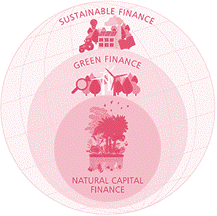
Source: Dasgupta, The Economics of Biodiversity: The Dasgupta Review, p.477, 2021
Figure 5: Categories of Finance
The category of private investment that covers the approaches to investments that consider non-financial factors, such as environmental and diversity ones, coupled with financial considerations, such as profits, is called sustainable investing. Green investment comes as a subcategory of the sustainable investing agenda and is concentrated on nature and the environment. Green finance incorporates a range of mechanisms and instruments such as green bonds and equity investment funds in environmental projects. Private financial investments in natural capital are usually viewed as a subset of the two previous categories (Figure 5; Dasgupta, 2021, p. 476-477). Private finance actors can also influence the broader adoption of sustainable processes through stakeholder or corporate engagement. Evidence suggests that investors’ engagement with businesses in relation to sustainability issues tend to influence business activities and processes (Dasgupta, 2021, p.482). To ensure prudent SDG finance, it is necessary for the banking sector to develop standardized assessment tools that consider the sustainability impact of the financial products and services along with their financial risks and opportunities through embedding SDG-related criteria into financial decision-making. Weber (2019) suggests at least three ways that the financial sector can support the SDGs, namely impact investment, socially responsible investment and sustainable banking. Although impact investment and sustainable banking take a more proactive stance in promoting investments that help achieve SDGs, socially responsible investment is currently bigger and adopts a more passive stance vis- à-vis the SDGs.
4. SDGS AND THE COVID-19 PANDEMIC
The COVID-19 pandemic presents a unique opportunity to build back better. Crises and breakdowns can be the primary source of transformation as they remove barriers and institutional rigidities that previously stood in the way of sustainability. Through engaging in the second phase of crisis leadership, namely the adaptive phase, the underlying causes of the crisis are supposed to be tackled and the capacity to thrive in a new reality needs to be built (Monkelbaan, 2019, p. 183). The fight against COVID-19 has largely become a fight against poverty and structural inequality. Consequently, responding effectively to the COVID-19 crisis should permit the change of mentality required to address the cracks in the system and the root causes of vulnerabilities, thus allowing for building back better in the context of implementing longer-term policies that can bring about meaningful structural changes. This entails moving beyond “responses based on short-term economic fixes” and concentrating on enacting long-term policies (OECD 2020b; UCLG, 2020; UN DESA, 2020). The response to COVID-19 should take into consideration past, present and future experiences. For instance, COVID-19 gives us a glimpse of a 2030 world where the SDGs are failed as most of the vulnerabilities highlighted by the pandemic are incorporated and addressed in the SDGs (Deloitte, 2020). This fact underscores the urgency to follow a coherent multidimensional, systematic approach rather that a sector by- sector sequential approach in responding to the crisis to address its interconnected dimensions (OECD 2020b; UNDP, 2020). This becomes imperative with revised estimates that show that 132 million people will be pushed into extreme poverty by climate change by 2030 and the increase of zoonotic diseases as a result of biodiversity loss and shifting of wild animals’ habitats (Deloitte, 2020; Jafino et al., 2020). Additionally, the response should be framed through an equity lens as the countries, communities and groups already lagging along various dimensions are the ones particularly affected and leaving them further behind will have long-term impacts on human development (UNDP, 2020). Taken altogether, the complexity of the required response should benefit from previous experiences such as mechanisms used in fighting diseases like Ebola, bird flu and MERS and in tackling the 2008 financial crisis. Establishing a greener world economy after the COVID-19 pandemic for instance dictates learning from what worked and what failed from past efforts to adopt green stimulus during the 2008-9 Great Recession, especially given the large size and range of countries’ fiscal responses to the crisis that would shape the climate for decades (UNDEP, 2020; IMF, 2020b).
One important factor that should be considered in designing recovery policies is the fact that the concept of sustainability is not limited to dealing with climate change and biodiversity loss. While fighting the climate crisis has become imperative, it is crucial to think of it as one of the 17 SDGs and design policies that build on the interdependency across multiple SDGs (Barbier et al., 2020; Mohieldin, April 2021). If the world, especially Emerging Markets and Developing Countries (EMDCs), focuses on climate and biodiversity at the cost of people, economic, partnerships and governance SDGs, we might end up with a two-tier system; one that would involve a fast track towards achieving SDG 13 and a slower second track for the remaining SDGs (Mohieldin, March 2021). This would entail a waste of the advantages that come from integrating the SDGs and the unity of their financial implementation framework (Mohieldin, April 2021). Additionally, the cruciality of other SDGs, as exposed by the COVID-19 crisis, makes it imperative to transcend the idea of co-benefits. While climate action and environmental preservation are expected to have significant indirect effects on human development and economic growth, it is dangerous to leave such critical areas to the chances of co-benefits. In that regard, in the recovery phase, combating climate change and preserving the environment should be within the operational framework of governance and international partnerships to guarantee solid and coherent efforts on the economic, social and environmental aspects to reach a better performance in poverty and inequality (See Figure 6).
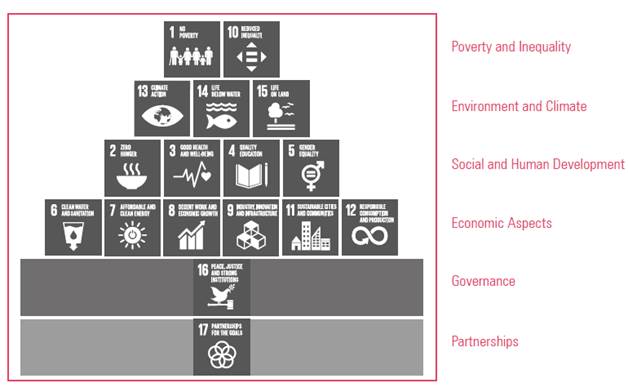
Source: Presentation by Mahmoud Mohieldin, ERF, May 2021
Figure 6: SDGs Framework for Building Back Better
The COVID-19 has also provided a new lens to reimagine the roles played by the different actors in achieving the SDGs. Many national governments have climate action at the heart of their stimulus plans. For instance, the EU’s $750 billion stimulus plan and its $1.1 trillion 2021-2027 budget earmark 30% for climate- friendly investments and $17.5 billion to cut reliance on fossil fuels (Council of the European Union, July 2020). In November 2020, the United Kingdom announced its ‘Ten Point Plan for a Green Industrial Revolution’, which will mobilize more than $13 billion of government investment to create and support up to 250,000 highly- skilled green jobs and spur over three times as much private sector investment by 2030 (UK Prime Minister’s Ofice, November 2020). Following the same path, in July 2020, the South Korean Government announced its $133 billion ‘Korean New Deal’ stimulus, of which $94.6 billion will be financed by the treasury with $35.4 billion are directed to Korea’s ‘Green New Deal’ that aims to strengthen climate action and realize a green economy through investments that focus on green infrastructures, renewable energy, and fostering green industry (Government of the Republic of Korea, July 2020). Equally important is the US President-Elect Joe Biden’s commitment to put the United States on an irreversible path to achieve net-zero emissions, economy-wide, by no later than 2050 with a plan to make a $2 trillion accelerated investment (Joe Biden, 2020).
Efforts of some national governments to build back better have gone beyond incorporating climate action in their stimulus packages. With the start of the decade of action, some governments have pioneered and introduced mandatory climate- related financial disclosures requirements in line with the TCFD recommendations. For instance, New Zealand announced in September 2020 that it will implement mandatory climate risk reporting in line with the TCFD recommendations. Businesses covered by the requirements will have to cover governance arrangements, risk management, and strategies for mitigating any climate change impacts in their annual disclosures (New Zealand, 2020). In a similar vein, the United Kingdom announced on 9 November 2020 that it will require large companies to disclose climate risks by 2025, with a significant portion of mandatory disclosure requirements taking place in 2023 (HM Treasury, 2020). Other countries like Australia, Canada, France, Japan, and the European Union are all working towards some form of climate risk reporting for companies, thus highlighting governments’ tendency to include climate risk and resilience into the core of financial and business decision making.
The change in the policy scene compounded by the pandemic and the rise of stakeholder activism entails a change in the environment in which businesses are required to operate. Taken altogether, the COVID-19 provides a unique opportunity for companies that act responsibly to make a long-lasting positive impact on stakeholder’s perceptions. Compromising with the SDGs and the achievement of a sustainable development agenda, even in times of crisis, is a powerful vehicle for companies to prove their sustainability case and it will position them ahead of competition (WEF, 2020). By presenting an opportunity to take actions and the imperative to show leadership and solidarity, the COVID-19 pandemic presents companies with the chance to prioritize the right global goals in their strategy agenda. Consequently, companies which act are not just able to anticipate the disruption that is possible to appear in the future, but also to shape the direction of the disruption to their competitive advantage (Van Tulder, 2018; WEF, 2020).
5. A FORWARD LOOK TOWARDS ACHIEVING THE SDGS”:
Less than ten years are remaining before reaching the deadline of achieving the SDGs by 2030. Five precious years were lost from the day of launching the SDGs in 2015 before the eruption of the pandemic in 2020 which had its toll on the critical indicators of SDGs. We cannot blame it all on the pandemic as a reason for lack of progress, and there is still an opportunity to accelerate the progress towards attaining the SDGs. However, this warranted acceleration will depend on the progress of three critical factors: dependable data, adequate finance and effective implementation of development policies and programs including the delivery at the last mile.
1. Better Data to guide Policy
The one common denominator that cuts across the 2030 agenda is the presence of adequate, timely and comparable data as shown in the left panel of Figure 7 (Mohieldin, August 2020). The significance of timely, quality, open and disaggregated data and statistics has never been as clear as during the COVID-19 pandemic.
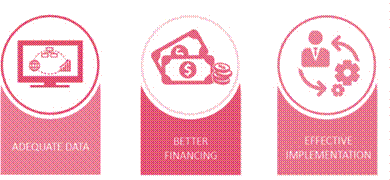
Source: Presentation by Mahmoud Mohieldin, Durham University, August 2020
Figure 7: What will the SDGs require? Data, Finance and Effective Implementation
The availability of such data is crucial in understanding, managing, and responding to the multidimensional effects of the pandemic as well as in designing accelerated actions towards achieving the SDGs. Many of the data challenges and gaps encountered during the first half decade of the SDG implementation are themselves limiting effective COVID-19 responses (UN, 2020a). Despite the progress that has been made in increasing the availability of internationally comparable data for SDG monitoring and growing evidence of using satellite imagery and other innovative techniques, persistent data gaps and lags remain in many countries. For instance, on average, as of 2019 countries in Africa and Asia have available data to monitor only 20% of SDG indicators, and only 35% of sub-Saharan African countries have poverty data collected since 2015 (SDSN TRENDS, 2019). There are still struggles to track the estimated 25.4 million refugees that are missing from national statistics worldwide (SDSN TRENDS, 2019). More generally, based on an analysis of the indicators in the Global SDG Indicators Database, for 4 out of the 17 goals, less than half of the 194 countries have internationally comparable data (Figure 8; UN 2020a). And even for countries with available data, only few observations are recorded, and a large number of SDG indicators are available only with a significant time lag, thus preventing policymakers to monitor progress and identify trends (Figure 9; UN 2020a).
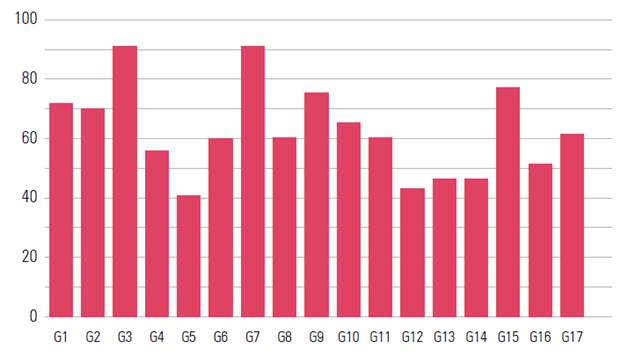
Source: UN, The Sustainable Development Goals Report, p.4, 2020
Figure 8: Data coverage. Note: Proportion of countries or areas with available data (weighted average across indicators), by goal (percentage)
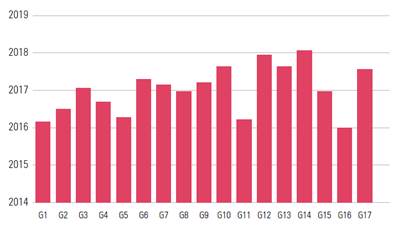
Source: UN, The Sustainable Development Goals Report, p.4, 2020 Note: The most recent year available (weighted average of the median country by indicator), by goal
Figure 9: Data timeliness
The COVID-19 crisis has come to exacerbate global data inequalities. Based on a survey conducted by the United Nations and the World Bank, 97% of the countries surveyed in sub-Saharan Africa indicated that the production of regular statistics was affected by the pandemic and 88% of the countries in Latin America and the Caribbean indicated that they encountered dificulties meeting international data reporting requirements. Moreover, the survey shows that 9 in 10 national statistical ofices in low-and lower-middle-income countries have witnessed funding cuts and are struggling to maintain regular operations (Figure 10; UN 2020a).
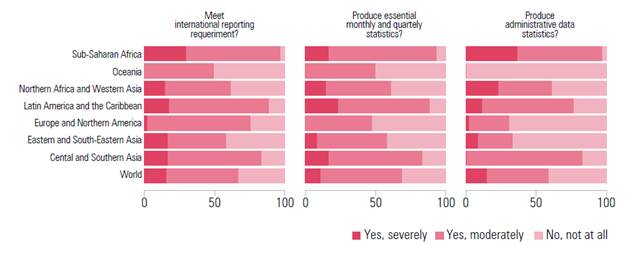
Source: UN, The Sustainable Development Goals Report, p.5, 2020
Figure 10: COVID-19 impact on international reporting, producing essential regular statistics and administrative data statistics
It has become imperative to invest in data and statistics capacities to maintain adequate coverage of all population groups as well as of natural resources. This would require finding innovative techniques to augment traditional statistical methods that have been disrupted by the pandemic (SDSN TREND, 2019; UN, 2020a). For example, multiple countries should start to fully digitalize their data collection through telephone and web-based surveys, along with using administrative data with newer data sources to produce oficial statistics. Countries should also integrate geospatial with statistical information to enhance the ability of policymakers to tailor responses to local circumstances across geographic space and time (UN, 2020a). Building and maintaining robust, inclusive and national data systems is only possible through: right governance, strong legal and policy support, incentive for innovation and partnerships, and finding the fiscal space to ensure long-term production (SDSN TRENDS, 2019).

Source: OECD. Global Outlook on Financing for Sustainable Development 2021: A New Way to Invest for People and Planet, 2020
Figure 11: COVID-19 impact on SDG Financing for Developing Countries
As mentioned earlier, prior to the COVID-19 pandemic, SDGs financing levels were insuficient. The pandemic is expected to widen the financing gap. Estimates shows that developing countries are set to witness a USD 700 billion dollar drop in external private finance along with a gap of USD 1 trillion in public spending on COVID-19 recovery measures compared to advanced economies (OECD, 2020b). The SDG Investment Trends Monitor further shows that the drop in SDG-related investments was much greater in developing and transition economies compared to developed ones. Moreover, the public support packages in developed countries are set to fuel asymmetric effect on global SDG investment trends, leading to gains in investment in renewable energy and digital infrastructure as a first sign (UNCTAD, 2020). The whole outlook is estimated to bring the SDG financing gap to USD 4.2 trillion in the developing economies (Figure 11; OECD, 2020b). This outlook comes at an instant where global financial assets are at their highest value since before the global financial crisis and estimates showing that the global assets under management stand at more than USD 110 trillion (Figure 12; PwC, 2020). However, the trillions available in the financial system are asymmetrically distributed, with only 20% of the financial assets held in developing countries where 80% of the population live. Also, despite a significant growth in sustainable development instruments, the growth is not fast enough to catch up with the financing gap and most of the funds circulating in developed economies that are devoted to the SDGs focus climate change mitigation and renewable energy (Figure 13). Additionally, the trillions in the financial system continue to fuel inequalities and unsustainable investments as the lack of universally accepted criteria impedes knowing their sustainable development impact and opens the door for increased risk of SDG washing and threatening the long-term value of assets (OECD 2020b, UNCTAD 2020).
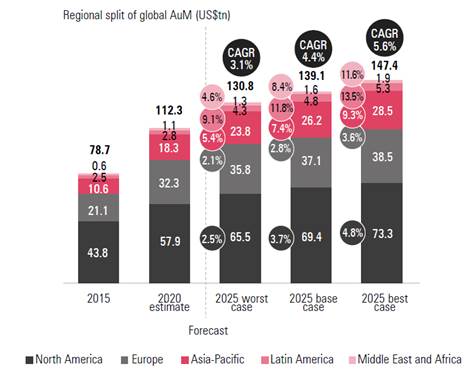
Source: PwC. Asset and wealth management revolution: The power to shape the future, 2020
Figure 12: Global Assets Under Management (AuM)
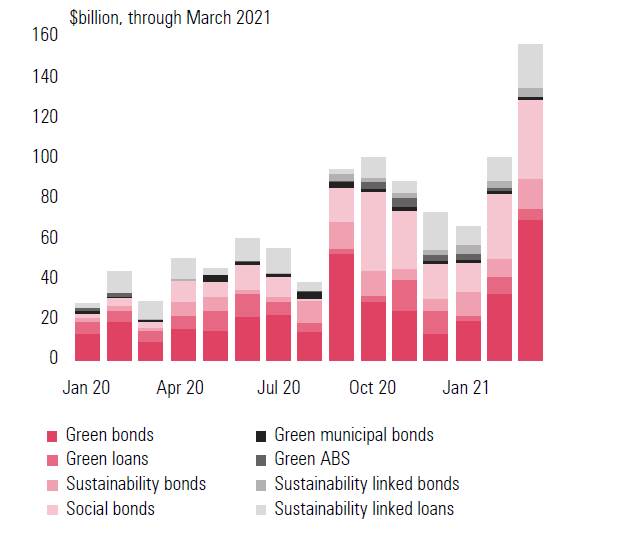
Source: Presentation by Mahmoud Mohieldin, ERF, May 2021. Numbers are based on data from the International Institute of Finance, April 2021
Figure 13: Global Sustainable Debt Issuance by Asset Class, monthly
The biggest challenge that faces SDG financing is how to attract the financial assets in the system towards SDG financing and finding a mechanism for channeling funds to the developing economies. Governments in all countries should work to provide better incentives to guide financing and attract the trillions available in the system. This should be coupled with efforts to increase the transparency and accountability of finance flows which would result from a direction to make sustainability reporting mandatory for financial and non-financial institutions, based on globally harmonized standard disclosure requirements (GISD, 2020; OECD, 2020b; Zhan et al., 2021). Developed economies can also facilitate the flow of funds, especially sustainable ones, to developing economies through sovereign guarantees and support. However, this should be accompanied with efforts from developing countries to enhance their business environments, increase the clarity of their investment policies and lay a strong foundation for regulations, all within the adoption of a holistic and comprehensive policy framework. The widening of the financing gap also raises the necessity of focusing on new innovative products, apply creativity to market solutions and innovate towards structures that will accelerate and scale funding, especially in developing countries where risks pose significant barriers to private sector investing (GISD, 2020; Zhan et al., 2021).
The fruit of targeted, ambitious and comprehensive set of SDG investments can surpass pre-COVID-19 progress in many areas, especially poverty. In that regard, the UNDP and the Frederick S. Pardee Center for International Futures propose a “SDG Push” investment scenario which consists of targeted interventions in inclusive green growth, which is based on integrated policy choices in governance, social protection, green economy and digitalization (Abidoye et al., 2021). The simulations of the SDG push scenario, in low and medium human development countries, show that this set of investments can exceed the pre-pandemic pace of fighting poverty (Figure 14; Abidoye et al., 2021). Furthermore, an SDG push can reduce the number of people living in extreme poverty in these countries by more than 100 million relative to the COVID-19 baseline scenario, with up to 50 million women and girls potentially lifted by 2030. The benefits of this scenario also apply to other SDGs in the People’s pillar, with 70-million reduction in malnutrition and improved health outcomes, educational completion and water and sanitation access (Abidoye et al., 2021).
2. Smarter and greener Implementation
Pre-COVID-19 the route towards 2030 was characterized by slow, unharmonized progress on many dimensions and reversed progress on others. As mentioned earlier, the SDGs offer a blueprint for a better recovery through full integration of environmental, social and economic impacts and trade-offs. The gaps inherent in the global system, the underfunding of public goods, the failure of markets and the unequal distribution of vulnerability across countries and individuals can be tackled by the holistic approach of the 2030 Agenda (OECD, 2020b; UN DESA, 2020; Mohieldin, April 2021). Combined with the results from SDG push scenario simulations, decision makers should be looking towards recovery and beyond as we approach 2030. This entails making choices and managing complexities and uncertainties in four main areas, as proposed by the UNDP and the Frederick S. Pardee Center for International Future, namely green economy, digitalization, governance and social protection (Figure 15; UNDP, 2020b).
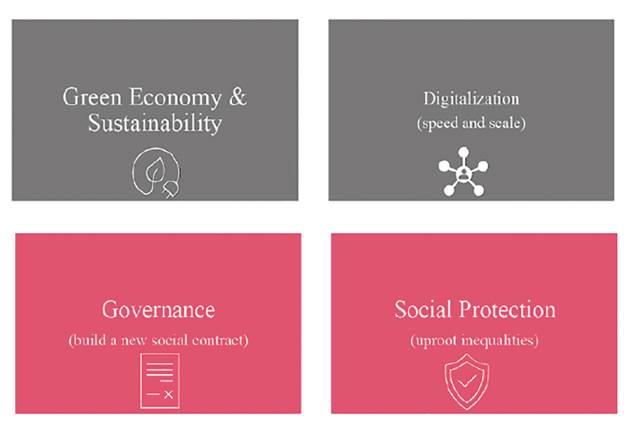
Source: Adapted from UNDP. Assessing impact of COVID-19 on the Sustainable Development Goals, 2020
Figure 15: Areas of effective implementation
The first area of green economy focuses on rebalancing nature, climate and the economy through designing and de-risking nature-based solutions, transforming agriculture systems and consumption patterns, cultivating sustainable public-private partnerships in areas such as ecotourism and green transport systems, aligning the financial system with the broader energy transition requirements, among other mechanisms (IRENA, 2018; UNDP, 2020b; Mohieldin, May 2021). This comes in the light of research that shows that the value of decarbonizing the global economy by 2050 would be eight times the cost, accounting for health and education benefits (IRENA, 2018). Digital disruption and innovation is the second area and it incorporates investments in digital transformation that target increased spending on research and development and closing the internet gap to catch up with the surge in tele-schooling, tele-medicine and remote work (UNDP, 2020b; UNDP, 2020c). These targeted investments come in the light of estimates showing that divides in access to online schooling has resulted in 86% of children in primary education being effectively out-of-school in low human development countries compared to only 20% in high human development countries (UNDP, 2020a). The third area of effective implementation is governance through building a new social contract to advance cohesion and gender equality while promoting human rights and upholding the rule of law (UNDP,2020b; UNDP, 2020c). The last area is strengthening social protection with the aim of uprooting inequalities that plagued the system even before the onset of the pandemic. Building resilient social protections systems that are capable of weathering shocks, designing a new generation of green jobs to support youth-led entrepreneurship and finding strategies for the informal sector workers should be areas of partnerships between the public and the private sectors (UNDP, 2020c).
To conclude; reflecting on the contribution of the different actors in using the SDGs to develop long- term plans to address the root causes as well as the impacts of the pandemic using country experience should be an area of active research. Additionally, reconciling the need for immediate and quick short-term response to the immediate effects of the pandemic with the longer-term plans to build back better should be tackled as new strains of the pandemic continue to hit and with the uneven rates of vaccinations across countries. The shape of the decade of action and the roles played by the different actors in placing the SDGs at the heart of the recovery from the pandemic is to be shaped by multiple factors. These factors include the change in the policy environment dictated by and upon national governments, accompanied by a shift in citizens’ values and expectations, an accelerated momentum for the roles played by local governments and communities and the imperative to go beyond business pioneers in incorporating the SDGs in the businesses core strategies.













